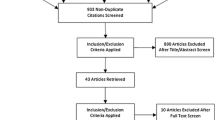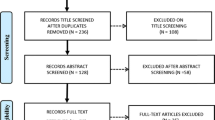Abstract
Summary
This systematic review provides synthesised knowledge and guidance to health professionals on the experiences and perspectives of being diagnosed with osteoporosis from the patient’s point of view. Using individuals’ experiences and meanings can promote tailored and targeted information and guidance on osteoporosis, bone care and treatment at different stages of the osteoporosis trajectory.
Introduction
To be diagnosed with osteoporosis with or without fragility fractures affects individuals differently. The aim of this review was firstly to aggregate existing qualitative evidence regarding an individual’s experience of being diagnosed with osteoporosis at different stages, and secondly, to use a systematic approach to develop a conceptual understanding of central issues relevant for health professionals in order to provide support and guidance to patients/individuals.
Methods
This study used a systematic review methodology and methods for qualitative synthesis as recommended by Cochrane and integrated the findings of qualitative research from eight databases (Medline, PubMed, CINAHL, Embase, SweMed+, PsycINFO, ERIC, Web of Science) to July 2016. Selection and assessment were performed by three authors while four authors were involved in the analysis. Findings were cross-checked with the original article to ensure consistency with the individual’s accounts.
Results
Our findings have revealed that individuals diagnosed with osteoporosis do not perceive osteoporosis as a biomedical trajectory but as a self-perceived continuum of severity and health. To be diagnosed with osteoporosis affects individuals differently depending on, for example, personal experience, pre-conceived notions of or knowledge about the disease, fragility fractures or pain. Hence, individuals will create a meaning of the diagnosis based on self-perceived fracture risk, self-perceived severity of osteoporosis and at the same time, self-perceived health.
Conclusions
This meta-synthesis provides knowledge for health professionals on the experiences and perspectives of being diagnosed with osteoporosis from the patient’s point of view. The experience, meaning and significance of osteoporosis must be taken into consideration and can be used to promote tailored and targeted information and guidance on osteoporosis, bone care and treatment at different stages of the osteoporosis trajectory.


Similar content being viewed by others
References
Vestergaard P, Rejnmark L, Mosekilde L (2005) Osteoporosis is markedly underdiagnosed: a nationwide study from Denmark. Osteoporos Int 16(2):134–141
Hernlund E, Svedbom A, Ivergard M, Compston J, Cooper C, Stenmark J et al (2013) Osteoporosis in the European Union: medical management, epidemiology and economic burden. A report prepared in collaboration with the International Osteoporosis Foundation (IOF) and the European Federation of Pharmaceutical Industry Associations (EFPIA). Arch Osteoporos 8:136
Osteoporosis prevention, diagnosis, and therapy. NIH Consens Statement 2000;17(1):1–45
Schwarz P, Jorgensen NR, Abrahamsen B (2014) Status of drug development for the prevention and treatment of osteoporosis. Expert Opin Drug Discovery 9(3):245–253
Weston JM, Norris EV, Clark EM (2011) The invisible disease: making sense of an osteoporosis diagnosis in older age. Qual Health Res 21(12):1692–1704
Rothmann MJ, Huniche L, Ammentorp J, Barkmann R, Gluer CC, Hermann AP (2014) Women’s perspectives and experiences on screening for osteoporosis (Risk-stratified Osteoporosis Strategy Evaluation, ROSE). Arch Osteoporos 9:192
Gerend MA, Erchull MJ, Aiken LS, Maner JK (2006) Reasons and risk: factors underlying women’s perceptions of susceptibility to osteoporosis. Maturitas 55(3):227–237
Siris ES, Gehlbach S, Adachi JD, Boonen S, Chapurlat RD, Compston JE, Cooper C, Delmas P, Díez-Pérez A, Hooven FH, LaCroix AZ, Netelenbos JC, Pfeilschifter J, Rossini M, Roux C, Saag KG, Sambrook P, Silverman S, Watts NB, Wyman A, Greenspan SL (2011) Failure to perceive increased risk of fracture in women 55 years and older: the global longitudinal study of osteoporosis in women (GLOW). Osteoporos Int 22(1):27–35
Ballard K (2002) Understanding risk: women's perceived risk of menopause-related disease and the value they place on preventive hormone replacement therapy. Fam Pract 19(6):591–595
Rothmann MJ, Ammentorp J, Bech M, Gram J, Rasmussen OW, Barkmann R, Glüer CC, Hermann AP (2015) Self-perceived facture risk: factors underlying women’s perception of risk for osteoporotic fractures: the risk-stratified osteoporosis strategy evaluation study (ROSE). Osteoporos Int 26(2):689–697
Sale JE, Gignac MA, Frankel L, Hawker G, Beaton D, Elliot-Gibson V et al (2012) Patients reject the concept of fragility fracture—a new understanding based on fracture patients’ communication. Osteoporos Int 23(12):2829–2834
Sujic R, Gignac MA, Cockerill R, Beaton DE (2013) Factors predictive of the perceived osteoporosis-fracture link in fragility fracture patients. Maturitas 76(2):179–184
Gregson CL, Dennison EM, Compston JE, Adami S, Adachi JD, Anderson FA Jr et al (2014) Disease-specific perception of fracture risk and incident fracture rates: GLOW cohort study. Osteoporos Int 25(1):85–95
Giangregorio L, Papaioannou A, Thabane L, DeBeer J, Cranney A, Dolovich L et al (2008) Do patients perceive a link between a fragility fracture and osteoporosis? BMC Musculoskelet Disord 9:38
Giangregorio L, Dolovich L, Cranney A, Adili A, Debeer J, Papaioannou A et al (2009) Osteoporosis risk perceptions among patients who have sustained a fragility fracture. Patient Educ Couns 74(2):213–220
Rimes KA, Salkovskis PM (2002) Prediction of psychological reactions to bone density screening for osteoporosis using a cognitive-behavioral model of health anxiety. Behav Res Ther 40(4):359–381
Emmett CL, Redmond NM, Peters TJ, Clarke S, Shepstone L, Lenaghan E, Shaw ARG (2012) Acceptability of screening to prevent osteoporotic fractures: a qualitative study with older women. Fam Pract 29(2):235–242
Nielsen D, Huniche L, Brixen K, Sahota O, Masud T (2013) Handling knowledge on osteoporosis—a qualitative study. Scand J Caring Sci 27(3):516–524
Reventlow S, Bang H (2006) Brittle bones: ageing or threat of disease exploring women’s cultural models of osteoporosis. Scand J Public Health 34(3):320–326
Reventlow SD, Hvas L, Malterud K (2006) Making the invisible body visible. Bone scans, osteoporosis and women’s bodily experiences. Soc Sci Med (1982) 62(11):2720–2731
Wilkins S (2001) Women with osteoporosis: strategies for managing aging and chronic illness. J Women Aging 13(3):59–77
Reventlow SD (2007) Perceived risk of osteoporosis: restricted physical activities? Qualitative interview study with women in their sixties. Scand J Prim Health Care 25(3):160–165
Hjalmarson HV, Strandmark M, Klässbo M (2007) Healthy risk awareness motivates fracture prevention behaviour: a grounded theory study of women with osteoporosis. Int J Qual Stud Health Well Being 2(4):236–245
Bombak AE, Hanson HM (2016) Qualitative insights from the osteoporosis research: a narrative review of the literature. J Osteoporos 2016:7915041
Barker KL, Toye F, Lowe CJ (2016) A qualitative systematic review of patients’ experience of osteoporosis using meta-ethnography. Arch Osteoporos 11(1):33
Cochrane Handbook of Systematic reviews http://handbook.cochrane.org/chapter_20/20_qualitative_research_and_cochrane_reviews.htm Accessed 1–12-17
Torgerson C (2003) Systematic reviews. London: Continuum International Publishing Group
Noblit G HR. Meta-ethnography: synthesizing qualitative studies (Qualitative Research Methods) United States of America: Saga Publications, Inc.; 1988
Tong A, Flemming K, McInnes E, Oliver S, Craig J (2012) Enhancing transparency in reporting the synthesis of qualitative research: ENTREQ. BMC Med Res Methodol 12:181
Joanna Briggs Institute Reviewers’ Manual. https://joannabriggs.org/assets/docs/sumari/ReviewersManual-2014.pdf Accessed 1-12-17
World Health O, Risk WHOSGoAoF, its Application to Screening for Postmenopausal Osteoporosis Assessment of Fracture R, its Application to Screening for Postmenopausal O. Assessment of fracture risk and its application to screening for postmenopausal osteoporosis: report of a WHO Study Group. WHO technical report series. 1994:129 s
Kanis JA, Melton LJ 3rd, Christiansen C, Johnston CC, Khaltaev N (1994) The diagnosis of osteoporosis. J Bone Miner Res 9(8):1137–1141
Kristiansen KM BN, Tingleff EB, Rossen CB (2008) Litteratursøgning i praksi: begreber, strategier og modeller. Sygeplejersken 108(10)
Frandsen TF, Dyrvig AK, Christensen JB, Fasterholdt I, Oelholm AM (2014) A guide to obtain validity and reproducibility in systematic reviews. Ugeskr Laeger 176(7)
Moher D, Liberati A, Tetzlaff J, Altman DG (2009) Preferred reporting items for systematic reviews and meta-analyses: the PRISMA statement. J Clin Epidemiol 62(10):1006–1012
Hallberg I, Ek AC, Toss G, Bachrach-Lindstrom M (2010) A striving for independence: a qualitative study of women living with vertebral fracture. BMC Nurs 9:7
Hansen C, Konradsen H, Abrahamsen B, Pedersen BD (2014) Women’s experiences of their osteoporosis diagnosis at the time of diagnosis and 6 months later: a phenomenological hermeneutic study. Int J Qual Stud Health Well Being 9:22438
Nielsen DS, Brixen K, Huniche L (2011) Men’s experiences of living with osteoporosis: focus group interviews. Am J Mens Health 5(2):166–176
Sale JE, Ashe MC, Beaton D, Bogoch E, Frankel L (2016) Men’s health-seeking behaviours regarding bone health after a fragility fracture: a secondary analysis of qualitative data. Osteoporos Int 27(10):3113–3119
Sale JE, Gignac MA, Hawker G, Beaton D, Bogoch E, Webster F et al (2014) Non-pharmacological strategies used by patients at high risk for future fracture to manage fracture risk—a qualitative study. Osteoporos Int 25(1):281–288
Sale JE, Cameron C, Hawker G, Jaglal S, Funnell L, Jain R et al (2014) Strategies used by an osteoporosis patient group to navigate for bone health care after a fracture. Arch Orthop Trauma Surg 134(2):229–235
Solimeo SL, Weber TJ, Gold DT (2011) Older men’s explanatory model for osteoporosis. The Gerontologist 51(4):530–539
CASP http://media.wix.com/ugd/dded87_25658615020e427da194a325e7773d42.pdf Accessed 1–12-17
Kanis JA, Johnell O (1999) The burden of osteoporosis. J Endocrinol Investig 22(8):583–588
Reventlow SD (2008) Risikoopfattelse og osteoporose hos kvinder i alderen 60–70 år: en kvalitativ undersøgelse af risikooplevelse, kulturelle forestillinger, kropslige opfattelser og kropspraksis. University of Copenhagen
Sale JE, Gignac MA, Hawker G, Beaton D, Frankel L, Bogoch E et al (2016) Patients do not have a consistent understanding of high risk for future fracture: a qualitative study of patients from a post-fracture secondary prevention program. Osteoporos Int 27(1):65–73
Noble H, Smith J (2015) Issues of validity and reliability in qualitative research. Evid Based Nurs 18(2):34–35
Unnanuntana A, Gladnick BP, Donnelly E, Lane JM (2010) The assessment of fracture risk. J Bone Joint Surg Am 92(3):743–753
Funding
The review was supported by the Region of Southern Denmark. The funding agency had no direct role in the conduct of the study, data collection, analysis, and interpretation of the data or the preparation, review, and final approval of the manuscript.
Author information
Authors and Affiliations
Corresponding author
Ethics declarations
Conflicts of interest
All authors have completed the authorship and disclosure form. CM Jensen, AC Smith, and J Clemensen have no conflict of interest. PR Jakobsen and MJ Rothmann have received a speaker fee from Eli Lilly. AP Hermann serves on advisory Boards for Eli Lilly, Amgen, and she has received research funding from Eli Lilly, in addition to a speaker fee from Eli Lilly, GSK, Genzyme, Amgen. These disclosed interests are outside the submitted work.
Rights and permissions
About this article
Cite this article
Rothmann, M.J., Jakobsen, P.R., Jensen, C.M. et al. Experiences of being diagnosed with osteoporosis: a meta-synthesis. Arch Osteoporos 13, 21 (2018). https://doi.org/10.1007/s11657-018-0436-6
Received:
Accepted:
Published:
DOI: https://doi.org/10.1007/s11657-018-0436-6




